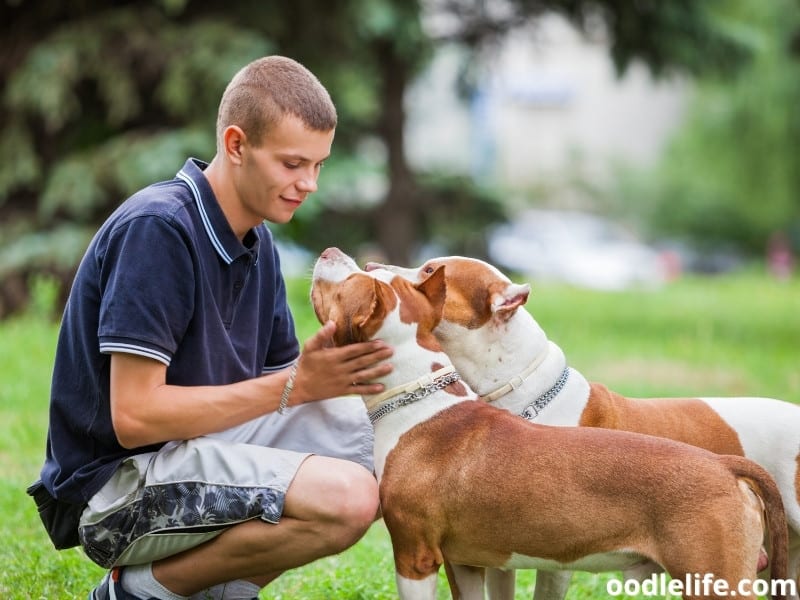When it comes to keeping our beloved pets safe and happy, one of the most important things to consider is how well they get along with each other. Unfortunately, not all dogs get along, and some may even find themselves in a bitter battle against another. This can be a stressful situation for pet owners, as they wonder if these two dogs can live together peacefully. In this blog post, we will explore the answer to the question, “Can two dogs that fight live together?” We will consider the causes of their fighting, discuss the steps you can take to help them coexist, and look at some tips for preventing future aggression. No matter what the issue is, it’s important to strive for balance and harmony in the home. With the right strategies, it is possible to bring peace to a home with two dogs that fight. It may be a challenge, but it is one that can be overcome with the proper guidance.
Ways to Prevent or Reduce Conflict Between Two Male Dogs
You can take a few steps to avoid or lessen conflict between two male dogs.
It may be best to speak with a qualified trainer or behaviorist who can assist you with managing the situation if you discover that your dogs are frequently fighting.

Recognizing When to Intervene
Co-authored by:
Make sure dogs in the same household have separate sleeping and feeding areas so they don’t become territorial and protective of their belongings and cause fights. Keep toys and treats out of reach and only give them to your dogs when you’re around to supervise if your dogs have a tendency to fight over them. Consider having your dogs spayed or neutered if you haven’t already because unfixed dogs are more likely to be aggressive. Scroll down for more suggestions from our veterinary co-author, including how to put an end to a dogfight.
What is a dominance hierarchy, and does this explain why dogs may fight?
Previously, the majority of common dog-dog interactions were described as a dominance hierarchy in which one dog was vying for control of resources like food, space, and preferred possessions in an effort to seize dominance. Current theories of canine behavior contest the validity of these underlying motives as an explanation of how dogs approach these confrontations. Dogs do exhibit a gradient of preferences and a variable desire for specific resources, and it is possible to predict how well they will be able to hold onto or secure these resources based on observation of previous encounters and conflicts. These supplies consist of food, lodgings, mates, territory, and prized possessions. The majority of the time, actions, postures, and facial expressions communicate one’s capacity to acquire these resources. When compared to a meeker, less self-assured, and less successful foe, the more courageous, assertive, and confident dog may believe his chances are good. Fighting is uncommon because when one dog submits or defers, the more courageous animal gets its way and relinquishes the challenge. In some homes, these displays may be minimal or nonexistent, while in others, they may be dramatic and appear to support a distinct hierarchy. Depending on health, prior experience, and relative motivation to obtain or maintain a resource, the apparent victor of these contests may change (i e. , who wants it more). While the idea that there is a linear hierarchy and that dogs are intent on successfully taking over the pack are not in dispute, communication of intention and submission are. Observations of wolf packs in the wild indicate that there is not a struggle for power among the wolves but rather that the wolves interact with their young in a similar way to human parents, providing for them, taking the lead when necessary, and instructing them until they are old enough to start their own packs. But since our family dogs are unrelated, they are unable to leave a group of people with whom they do not get along. According to Dominance, Alpha, and Pack Leadership – What Does It Really Mean? and Canine Communication – Interpreting Dog Language, this can lead to ongoing social stress, misunderstandings, and possibly aggressive interactions between dogs.
FAQ
How do you stop two dogs from fighting in the same household?
- Avoiding aggressive situations and triggers.
- Starting a “nothing in life is free” program.
- Giving preference to one dog.
- Desensitization and counter-conditioning.
- Medication, such as fluoxetine, to reduce anxiety and aggression.
Should you get in between two dogs fighting?
Physically intervene If done improperly, this method of disengaging a dogfight could be the most dangerous. To avoid getting bitten even by your own dog, never try to grab the collar or head of two fighting dogs or get in the middle of their fight.
Should you break up two dogs fighting?
When two dogs are obviously fighting, it is time to take physical action because the situation has become dangerous. A dogfight should ideally be broken up by two people. The most secure approach is called “the wheelbarrow.” Each person lifts a dog off the ground by its back feet.
Should I let my dogs fight it out?
No, if your dogs aren’t playing, you shouldn’t let them fight each other. Any of the techniques described in this article should be used to separate your dogs as soon as you realize they are actually fighting.